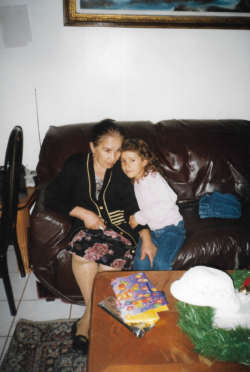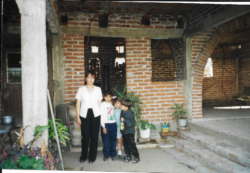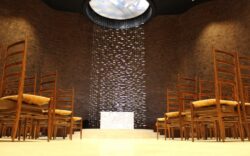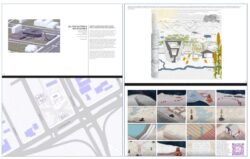


 MAF Scholarship recipient Rosa Manzo’s first architectural inspiration occurred when she visited Barcelona on a high school student trip. “I was astounded by the architecture of Antoni Gaudi and the thought that went into making spaces and buildings and had equal admiration and respect for the natural and physical sciences in Gaudi’s designs. Until then I had never heard people talk about buildings in such a way, and I was impressed by how a building could influence people, feelings, and even an entire community. It led me to pursue architecture as an undergraduate.”
MAF Scholarship recipient Rosa Manzo’s first architectural inspiration occurred when she visited Barcelona on a high school student trip. “I was astounded by the architecture of Antoni Gaudi and the thought that went into making spaces and buildings and had equal admiration and respect for the natural and physical sciences in Gaudi’s designs. Until then I had never heard people talk about buildings in such a way, and I was impressed by how a building could influence people, feelings, and even an entire community. It led me to pursue architecture as an undergraduate.”
However, Rosa was still unsure whether she wanted to become a licensed architect or pursue another design-related profession, until a pivotal event five years ago. “I was working on a renovation project for the US Army Corps of Engineers (while at Barge Design Solutions) at Wright Patterson Air Force Base in Dayton, Ohio. The buildings saw the processing and deployment of airmen as they filled out paperwork, said goodbye to their families, collected ammunition and equipment, and were briefed on their assignments. While these buildings were by no means architecturally interesting, there was grappling with the reality that they were significant for those utilizing them. It reinforced the idea of how impactful and influential architecture can be, and that experience cemented my desire to become a licensed architect.”
Rosa, who is in her final year of the three-year Master of Architecture program at University of Michigan’s Taubman College of Architecture and Urban Planning, was awarded both MAF’s 2021 Paul Stachowiak/Integrated Design Solutions (IDS) Scholarship and the 2021 AIA Michigan President’s Scholarship. “Being awarded both scholarships was such an honor, and I am immensely grateful to have received them. The awards allowed me the opportunity to focus on my studies without having to worry about money or the need to hold multiple jobs – something I have never had the economic ability to do. I am truly grateful to the MAF.”
 MAF’s scholarship application requires a student design portfolio and personal statement describing the student’s interest, experience and plans related to architecture. Rosa submitted projects including proposals for a children’s mediatheque in Boston and a community education center in South Africa, a sculptural auditory installation on MIT’s campus, and a virtual reality research study and exhibition at Perkins Eastman. (Rosa earned her Bachelor of Science in Architecture from MIT).
MAF’s scholarship application requires a student design portfolio and personal statement describing the student’s interest, experience and plans related to architecture. Rosa submitted projects including proposals for a children’s mediatheque in Boston and a community education center in South Africa, a sculptural auditory installation on MIT’s campus, and a virtual reality research study and exhibition at Perkins Eastman. (Rosa earned her Bachelor of Science in Architecture from MIT).
“In my personal statement, I mentioned my desire to explore the intersection of design, tectonics, accessibility, and equity as a female person of color within a male-dominated field,” said Rosa. “I recognize my role as an aspiring architect to be that of a public servant, and hope to create more accessible, equitable, and sustainable spaces for all.I also included information regarding my on-campus activity as a lab assistant and coordinator at the TCAUP fabrication lab, my involvement with NOMAS (National Organization of Minority Architects-student chapter), and leadership efforts as an undergraduate with Latinx student groups.”
 Rosa continues, “What I love most about architecture is how interdisciplinary it is and how ubiquitous it is in our everyday life. Architecture, and design in general, is something that’s embedded in the fabric of everything we do. It has the ability to influence how we feel and what we do – that is a lot to contend with and really daunting. But it also is what allows us to help make the world more inclusive and accessible.”
Rosa continues, “What I love most about architecture is how interdisciplinary it is and how ubiquitous it is in our everyday life. Architecture, and design in general, is something that’s embedded in the fabric of everything we do. It has the ability to influence how we feel and what we do – that is a lot to contend with and really daunting. But it also is what allows us to help make the world more inclusive and accessible.”
 In addition to being a dual MAF scholarship winner, Rosa also participated in the inaugural year (2020) of the MAF+AIA Michigan Bridge Internship Program. The program was created to help bridge the gap in available student architectural internships in Michigan due to COVID-19, and preserve educational, work experience, and career-boosting opportunities normally provided through the traditional internship experience. (Rosa did her bridge internship with Ann Arbor-based architecture firm, T+E+A+M).
In addition to being a dual MAF scholarship winner, Rosa also participated in the inaugural year (2020) of the MAF+AIA Michigan Bridge Internship Program. The program was created to help bridge the gap in available student architectural internships in Michigan due to COVID-19, and preserve educational, work experience, and career-boosting opportunities normally provided through the traditional internship experience. (Rosa did her bridge internship with Ann Arbor-based architecture firm, T+E+A+M).
Of Rosa’s many favorite works of architecture, two have been on her mind lately, “My paternal grandmother’s house in Michoacan, Mexico and the MIT Chapel by Eero Saarinen. My grandmother’s house brought my senses to life, and although I didn’t get to visit there often, it is one of my few vivid memories of being with her. The MIT Chapel is a cylindrical red brick building that plays with reflections and light. As an undergraduate student, I often visited it during moments of high stress, anxiety, and frustration, and it always managed to bring me some level of peace and calm.”
How does Rosa think architecture enriches life? “As I mentioned, architecture is so ubiquitous in our everyday lives and embedded in the fabric of everything we do. It has the potential to shape and benefit communities and influence feelings, in the same way that my grandmother’s house brought me joy and Saarinen’s chapel brought me peace. When practiced thoughtfully, effectively, and sustainably, architecture can help improve people’s lives and well-being. I don’t know if architecture alone can change and solve the world’s issues, but I do believe it can help improve or mitigate them. Everyone deserves access to good, healthy, and thoughtful design. “


Photos from top: Rosa; with her grandmother, at her grandmother’s home in Michoacan, Mexico; Rosa (second from left) with her mother and siblings; MIT Chapel by Eero Saarinen; Rosa (upper right) participating in a virtual La Mas lecture; work samples from Rosa’s design portfolio.